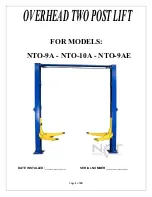
Page 14 of 20
i. Check safety lock audibly and visually while in operation. Check safety latches
for free movement and full engagement with rack.
ii. Check hydraulic connections, and hoses for leakage.
iii. Check chain and cable connection for bends, cracks and looseness.
iv. Check for frayed cables in both raised and lowered positions.
v. Check snap rings on all rollers and sheaves.
vi. Check bolts, nuts, and screws and tighten as needed.
vii. Check wiring & switches for damage.
viii. Clean any dirt, grease or any other corrosive substances from base plates.
ix. Check floor for stress cracks near anchor bolts.
x. Check swing arm restraints.
b. WEEKLY MAINTENANCE
i. Check anchor bolts torque to 120 ft-lbs.
ii. Check floor for stress cracks near anchor bolts
iii. Check hydraulic oil level and if low find leak you may have to replace or repair
cylinder or power unit.
iv. Check and tighten bolts and nuts, and screws.
v. Check cylinders for free movement. Look out for excessive ware on cylinder
yokes or pulley pins.
vi. Check cable pulleys for free movement and excessive ware.
c. YEARLY MAINTENANCE
i. Lubricate chain
ii. Grease rub blocks and column where they rub
iii. Change hydraulic fluid. Good maintenance procedure makes it mandatory to
keep hydraulic fluid clean. No hard fast rules can be established;, operating
temperature, type of service, contamination levels, filtration, and chemical
composition of fluid should be considered. If operating in dusty environment
shorter intervals may be needed.
MAINTENANCE
The following is the suggested maintenance schedule for this lift. If you hear or see any sign of
impending failure, cease operation immediately and inspect, correct and replace failed or
failing parts.
USERS SHOULD ALWAYS INSPECT LIFTING EQUIPMENT AT THE START OF EVERY
SHIFT. THESE AND OTHER PERIODIC INSPECTIONS ARE THE RESPONSIBILITY OF THE
USER/OWNER.
NOTE: Relocating or changing components may cause problems. Each component in the
system must be compatible; an undersized or restricted line will cause a drop in pressure. All
valve, pump, and hose connections should be sealed and/or capped until just prior to use. Air
hoses can be used to clean fittings and other components. However, the air supply must be
filtered and dry to prevent contamination. Most important - cleanliness - contamination is the
most frequent cause of malfunction or failure of hydraulic equipment.
a. DAILY PRE-OPERATION CHECK
ATTENTION! LOOK OUT!
Daily check of safety latch system is very important- the
discovery of device failure before needed could save you from expensive property
damage, lost production time, serious personal injury or even death.
Содержание NTO-10A
Страница 3: ...Page 3 of 20...






































